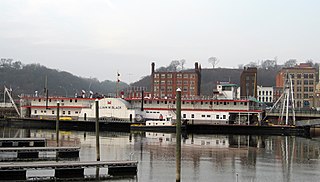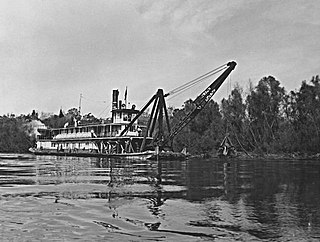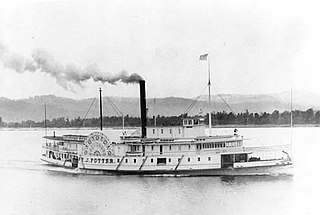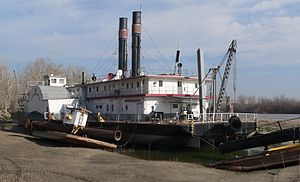
The Lewis and Clark Expedition, also known as the Corps of Discovery Expedition, was the United States expedition to cross the newly acquired western portion of the country after the Louisiana Purchase. The Corps of Discovery was a select group of U.S. Army and civilian volunteers under the command of Captain Meriwether Lewis and his close friend Second Lieutenant William Clark. Clark, along with 30 others, set out from Camp Dubois, Illinois, on May 14, 1804, met Lewis and ten other members of the group in St. Charles, Missouri, then went up the Missouri River. The expedition crossed the Continental Divide of the Americas near the Lemhi Pass, eventually coming to the Columbia River, and the Pacific Ocean in 1805. The return voyage began on March 23, 1806, at Fort Clatsop, Oregon, ending six months later on September 23 of that year.

The Missouri River is a river in the Central and Mountain West regions of the United States. The nation's longest, it rises in the eastern Centennial Mountains of the Bitterroot Range of the Rocky Mountains of southwestern Montana, then flows east and south for 2,341 miles (3,767 km) before entering the Mississippi River north of St. Louis, Missouri. The river drains semi-arid watershed of more than 500,000 square miles (1,300,000 km2), which includes parts of ten U.S. states and two Canadian provinces. Although a tributary of the Mississippi, the Missouri River is slightly longer and carries a comparable volume of water. When combined with the lower Mississippi River, it forms the world's fourth-longest river system.

Brownville is a village in Nemaha County, Nebraska, United States. The population was 142 at the 2020 census.

A steamboat is a boat that is propelled primarily by steam power, typically driving propellers or paddlewheels. Steamboats sometimes use the prefix designation SS, S.S. or S/S or PS ; however, these designations are most often used for steamships.

Meriwether Lewis was an American explorer, soldier, politician, and public administrator, best known for his role as the leader of the Lewis and Clark Expedition, also known as the Corps of Discovery, with William Clark. Their mission was to explore the territory of the Louisiana Purchase, establish trade with, and sovereignty over the natives near the Missouri River, and claim the Pacific Northwest and Oregon Country for the United States before European nations. They also collected scientific data, and information on indigenous nations. President Thomas Jefferson appointed him Governor of Upper Louisiana in 1806. He died in 1809 of gunshot wounds, in what was either a murder or suicide.

A paddle steamer is a steamship or steamboat powered by a steam engine that drives paddle wheels to propel the craft through the water. In antiquity, paddle wheelers followed the development of poles, oars and sails, where the first uses were wheelers driven by animals or humans.

Fort Mandan was the name of the encampment which the Lewis and Clark Expedition built for wintering over in 1804–1805. The encampment was located on the Missouri River approximately twelve miles (19 km) from the site of present-day Washburn, North Dakota, which developed later. The precise location is not known for certain. It is believed now to be under the water of the river. A replica of the fort has been constructed near the original site.

The Lewis and Clark National Historic Trail is a route across the United States commemorating the Lewis and Clark Expedition of 1804 to 1806. It is part of the National Trails System of the United States. It extends for some 4,900 miles (7,900 km) from Pittsburgh, Pennsylvania, to the mouth of the Columbia River in Oregon.

The Great Falls of the Missouri River are a series of waterfalls on the upper Missouri River in north-central Montana in the United States. From upstream to downstream, the five falls along a 10-mile (16 km) segment of the river are:

Lewis and Clark Lake is a 31,400 acre (130 km²) reservoir located on the border of the U.S. states of Nebraska and South Dakota on the Missouri River. The lake is approximately 25 miles (40 km) in length with over 90 miles (140 km) of shoreline and a maximum water depth of 45 feet (14 m). The lake is impounded by Gavins Point Dam and is managed by the U.S. Army Corps of Engineers, Omaha District.

Light Vessel Number 83 (LV-83) Swiftsure is a lightship and museum ship owned by Northwest Seaport in Seattle, Washington. Launched in 1904 at Camden, New Jersey and in active service until 1960 after serving on all five of the American west coast's lightship stations, it is the oldest surviving lightship in the United States, the only one still fitted with its original steam engine, and the last lightship with wooden decks. LV-83 was designated a National Historic Landmark in 1989, and has been undergoing major restoration since 2008.

The steamship Virginia V is the last operational example of a Puget Sound Mosquito Fleet steamer. She was once part of a large fleet of small passenger and freight carrying ships that linked the islands and ports of Puget Sound in Washington state in the late 19th and early 20th centuries. She is a Seattle landmark and a National Historic Landmark.

W. T. Preston is a specialized sternwheeler that operated as a snagboat, removing log jams and natural debris that prevented river navigation on several Puget Sound-area rivers. She is now the centerpiece of the Snagboat Heritage Center in Anacortes, Washington. She was designated a National Historic Landmark in 1989. Built in 1929, she is one of two surviving snagboats built and operated by the United States Army Corps of Engineers, and the only one on the American west coast.

CSS Muscogee was an casemate ironclad built in Columbus, Georgia for the Confederate States Navy during the American Civil War. Her original paddle configuration was judged a failure when she could not be launched on the first attempt in 1864. She had to be rebuilt to use dual propeller propulsion. Later renamed CSS Jackson and armed with four 7-inch (178 mm) and two 6.4-inch (163 mm) cannons. She was captured while still fitting out and was set ablaze by Union troops in April 1865. Her wreck was salvaged in 1962–1963 and turned over to the National Civil War Naval Museum in Columbus for display. The ironclad's remains were listed on the National Register of Historic Places in 1970.

William M. Black is a steam-propelled, sidewheel dustpan dredge, named for William Murray Black, now serving as a museum ship in the harbor of Dubuque, Iowa. Built in 1934, she is one of a small number of surviving steam-powered dredges, and one of four surviving United States Army Corps of Engineers dredges. She was declared a National Historic Landmark in 1992. She is open for tours as part of the National Mississippi River Museum & Aquarium.

Lone Star is a wooden hull, steam-powered stern-wheeled towboat in LeClaire, Iowa, United States. She is dry docked and on display at the Buffalo Bill Museum in LeClaire. Built in 1868, she is the oldest of three surviving steam-powered towboats, and the only one with a wooden hull. She was declared a National Historic Landmark on 20 December 1989.

Sergeant Floyd is a historic museum boat, serving as the Sergeant Floyd River Museum & Welcome Center at 1000 Larsen Park Road in Sioux City, Iowa. Built in 1932 as a utility vehicle and towboat, she is one of a small number of surviving vessels built specifically for the United States Army Corps of Engineers in its management of the nation's inland waterways. The boat has been restored and drydocked, and now houses exhibits about the Missouri River and local tourism information. The museum is a facility of the Sioux City Public Museum.

Montgomery is a steam-powered sternwheel-propelled snagboat built in 1925 by the Charleston Dry Dock and Machine Company of Charleston, South Carolina, and operated by the United States Army Corps of Engineers. Montgomery cleared snags and obstructions from the Coosa, Alabama, Apalachicola, Chattahoochee, Flint, Black Warrior, and Tombigbee Rivers until her retirement from the Corps of Engineers on November 8, 1982. She was restored in 1984 and again in 2004. One of only two surviving Army Corps of Engineers snagboats, she was declared a National Historic Landmark in 1989. Montgomery now operates as a museum ship at the Tom Bevill Lock and Dam Visitor Center in Pickensville, Alabama.

The T.J. Potter was a paddle steamer that operated in the Northwestern United States. The boat was launched in 1888. Her upper cabins came from the steamboat Wide West. This required some modification, because the T.J. Potter was a side-wheeler, whereas the Wide West had been a stern-wheeler. The boat's first owner was the Oregon Railway and Navigation Company. The T. J. Potter was one of the few side-wheeler boats that operated on the Columbia River.

A snagboat is a river boat, resembling a barge with superstructure for crew accommodations, and deck-mounted cranes and hoists for removing snags and other obstructions from rivers and other shallow waterways.





















